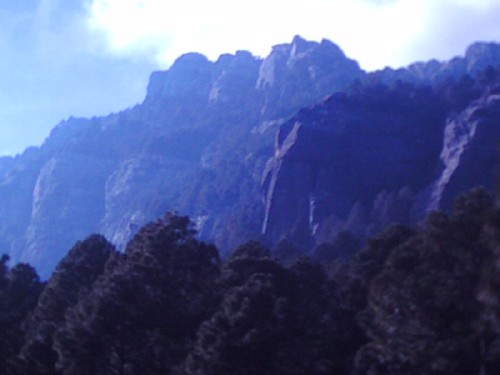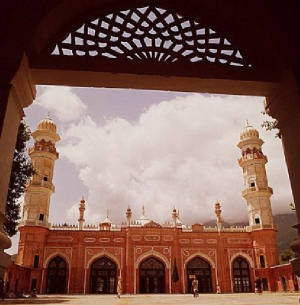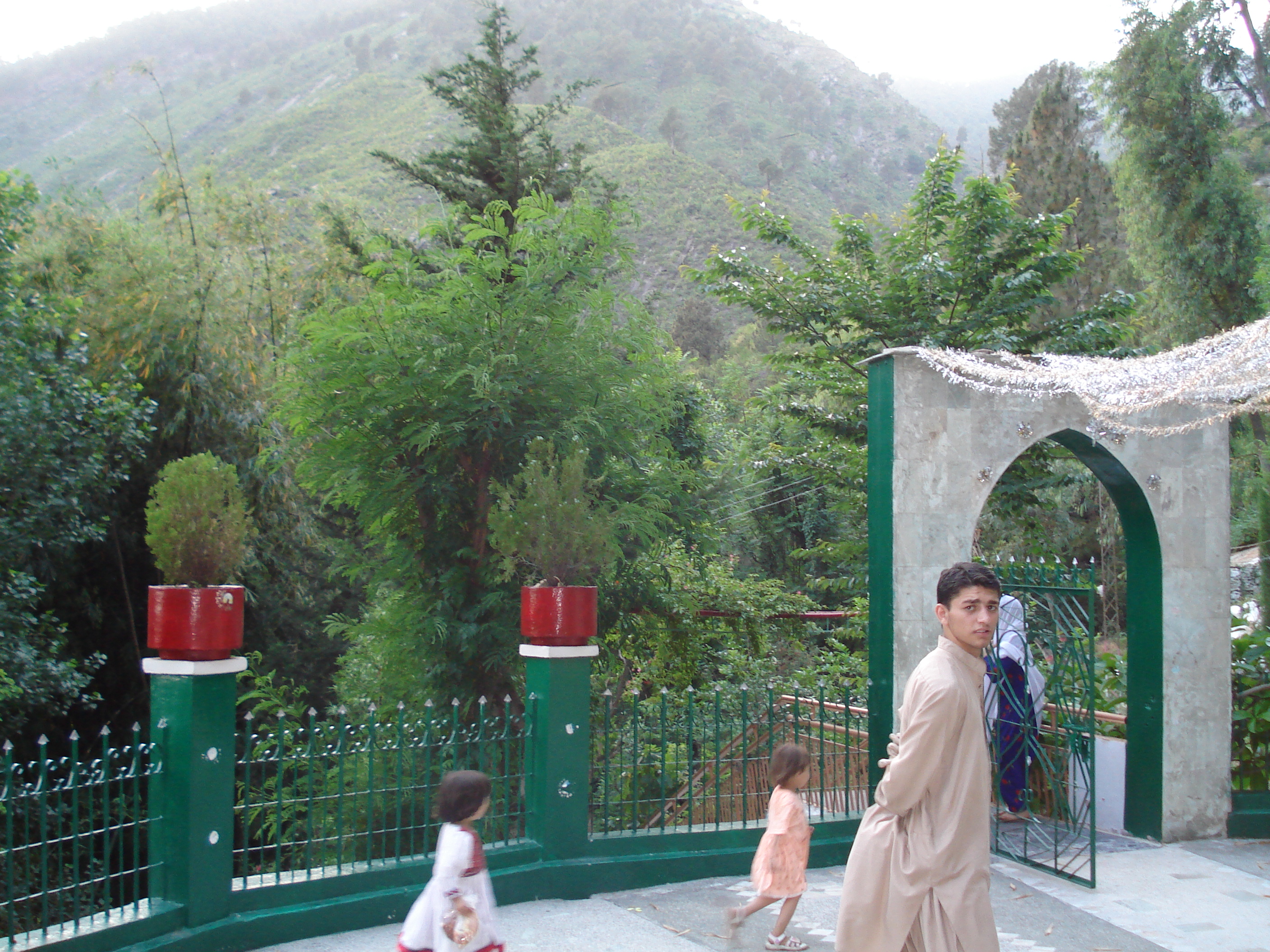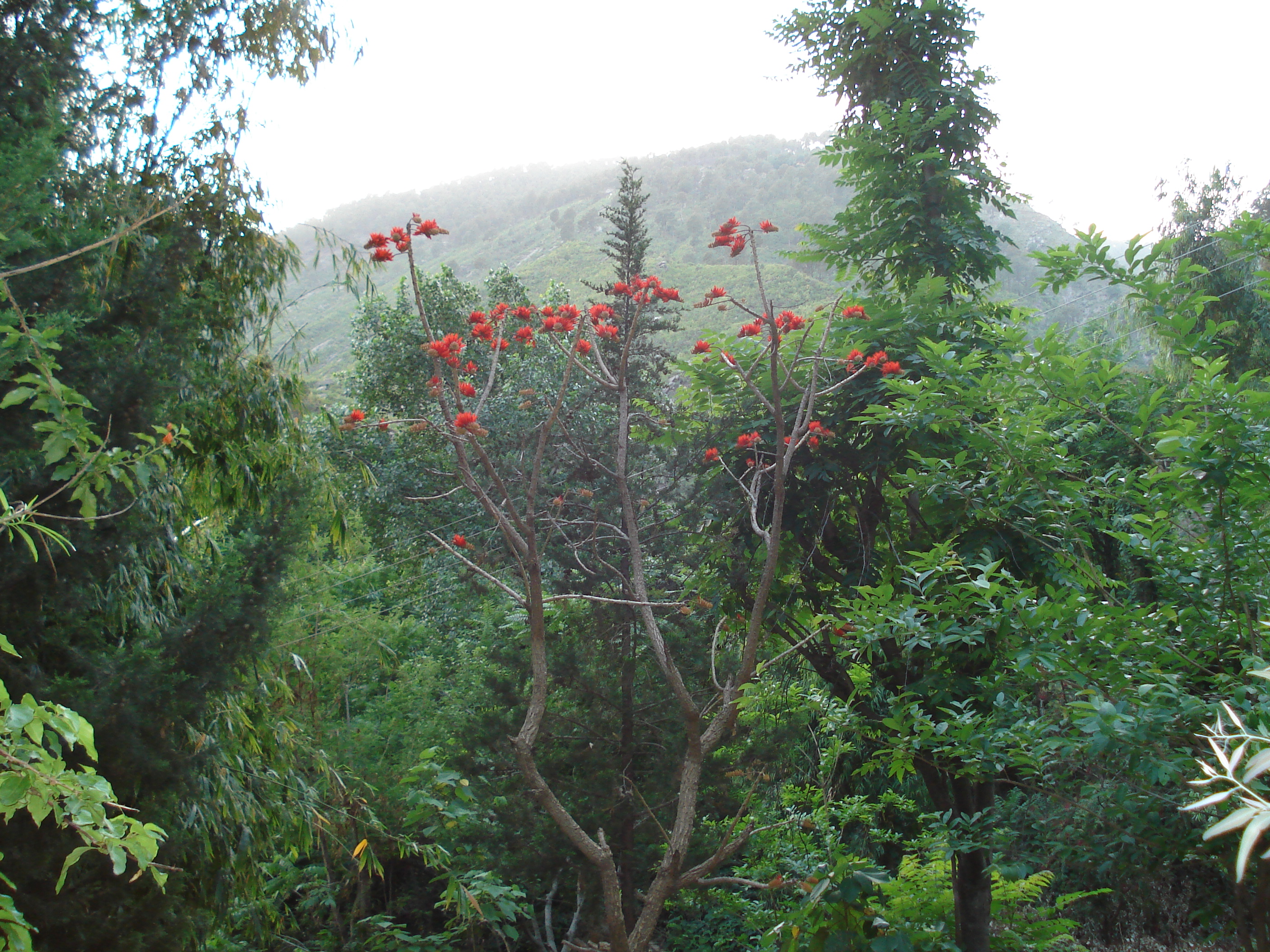Elum Ghar is a mountain of Pir Baba in the Buner District of
the North-West Frontier Province of Pakistan. It lies on the westside of Pir Baba. Its height is approximately 2,800 metres,
Mingora, a city of Swat Valley, can be seen from the top of Elum mountain.

Hiking this mountain is a popular activity due to the many gushing streams and beautiful lakes that can be seen while
going up the mountain.
Peryano Dand is a rectangular
natural lake on the Elum Ghar mountain in Pir Baba, Buner District, North-West Frontier Province, Pakistan.
The lake
is actually hosted by a bowl like huge rock. It is surrounded by very high rocks from three sides. It is roughly 20 metres
by 10 metres. It stretches east-west in length and north-south in width. Its depth varies from 2 feet to 10 feet. It is shallow
on its eastern edge, but very deep on other three sides, especially the north-west side where the waterfall gushes down. There
are rocks of different sizes on the eastern side, but the rest of the lake's bottom is sand.
The sandy bottom and
pleasant scenery make Peryano Dand a popular spot for swimming and diving. The lake is reachable by a substantial hike.
Weather
around the lake is cool year-round.
History:
It also hosts the old Indus civilisation, connected it to the ruins of Swabi and Swat valley.
Few of them have been dug by locals very roughly in search of the idols, utensils and other archaeological items but most
of the historic items are believed tp be still lying untouched. There is a great treasure of knowledge for the archaeologists
and historians in this mountain.
It is famous for its Snakes and Cobras near the top. There is a local proverb "Chey
maar zuan shi nu elum ta zee", i.e. when the snake becomes a youth, it goes to Elum.
Festivals: Every year at the end of July or at the beginning of August the
festival of "Jushn-e-Elum" is held, it is celebrated by the youth from nearby villages. They celebrate it to get
out of the heat of the valley and stay for a couple of days in the cold weather of the mountain.
Qadir Nagar:
A Commentary
Written and compiled by: Mehmooda Aziz
This commentary is based on a documentary made
on Qadir Nagar in 1988.
I the mountainous north, the valley of Swat is known to be one of
the most beautiful ad historically interesting valleys of Pakistan. In 327 BC, Alexander the Great invaded Swat on his way
from Afghanistan to the Indus. Later in 1928, the British government acknowledged Swat as a separate state and Miangul Waheed
became the 'Wali' or the ruler of Swat. His rule ended in 1969 and Swat became a part of Pakistan.
Pir
Baba,  a small village of District Bunair, in Swat, carries quite an attraction for the people from all over the country, as well
as for the tourists. The village was named after a great saint, Syed Ali Khurasani, commonly known as Pir Baba. Thousands
of pilgrims visit his shrine every year. In the beginning, it was a small community of people, including a number of Sikh
families who have settled down over here. Gradually the word about the miraculous healing powers of Pir Baba, especially curing
the leprosy cases. With time, people started pouring in from all over the country and eventually this small village took the
form of a small town, which now includes a commercial area as well.
a small village of District Bunair, in Swat, carries quite an attraction for the people from all over the country, as well
as for the tourists. The village was named after a great saint, Syed Ali Khurasani, commonly known as Pir Baba. Thousands
of pilgrims visit his shrine every year. In the beginning, it was a small community of people, including a number of Sikh
families who have settled down over here. Gradually the word about the miraculous healing powers of Pir Baba, especially curing
the leprosy cases. With time, people started pouring in from all over the country and eventually this small village took the
form of a small town, which now includes a commercial area as well.
As we step out of the village of
Pir Baba, a road is seen leading to a long stretch of beautiful Green Mountain ahead. This is the road that goes through a
small village called "Batai" which is a remote, but a very beautiful enchanting place, right in the lap of the mountains,
known as Qadir Nagar. Qadir Nagar, being an inaccessible and remote area, it took a couple of years to construct a jeepable
road, which still is subjected to deterioration during the Monsoons. Before the construction of this road, it was a tough
walk of five miles to reach Qadir Nagar. With the constant efforts of local workers and the people of Qadir Nagar, this road
now goes straight up to the mosque or rather The Wali Masjid. In September 1988, the government of Pakistan sanctioned a metalled
road, which has now materialsed into a nice road. The story of this road evolves a lot of constant effort and hard work for
its construction. Late Pasha Bhai’s limitless dedication had started the whole project work despite of innumerable hurdles
and difficulties. After he left us, the project came under the supervision of Janab Tahoor-ul-Islam. Initially, villagers
of Batai refused to give way for the road through their village. So the road was taken around Batai. It was Tahoor-ul-Islam
Sahib’s determination, devotion and expertise about the whole project, which has made it a success. The approximate
distance between Pir Baba and Qadir Nagar is about 5 miles. On starting the journey towards Qadir Nagar. From Pir Baba ‘White
Lines’ can be seen which indicate the location of Qadir Nagar.
After reaching the area of Qadir Nagar, the enchanting natural beauty around is so captivating that
one forgets all the tiredness. It is fascinating to watch such nice and attractive buildings in the middle of the huge Mountains
and rocks. It seems almost an unbelievable task of hard work and manpower. The first thing one notes as one approaches Qadir
Nagar, is the minaret of Wali Masjid, indicating Qadir Nagar – a symbol of man’s relationship to God, his creator.
An old professor of engineering saw in a very vivid dream – a spring, sprinkling out of a solid
wall of granite by a hillside and a flat stone close by. The dream was so vivid that he could not ignore it. After a month
he again saw in a dream that he is hiking on a hilly track – desolate and rocky, in company with a few local peasants.
Feeling exhausted and thirsty, on inquiring he was told that there is a spring nearby. Reaching the spot, The Professor was
wonder struck, when he remembered that it was the same spring. Seeing maps and hiking miles and miles, he reached the spring
and decided that I have to settle here. This distinguished Prof. Ubaidullah Khan Durrani, also known as Babajan, then decided
to build a hermitage there and it was named ‘Qadir Nagar’. At the very spring of water he had seen in his dream
and found it too!
In October 1963, the land was bought from a local farmer Mir Jabal. By the fall of
winter, the construction equipment was transported from Peshawar to Qadir Nagar. In just two days a small hut was built, which
later was reconstructed into a spacious guesthouse known as ‘Hujra’ – in the local language. It also has
one main room or a siting room. Photographs of some saints and sufis adorn the walls of this huge hall.
Any
type of construction on this land requires a lot of hard work, drilling, blasting of huge rocks and leveling of the ground.
People of this area are poor, but very hardworking. Construction work at Qadir Nagar has always provided the employment opportunities
to the local people.
Spring water in this area is extremely sweet and carries lots of essential minerals
for health. Water from the mountain springs is supplied to Qadir Nagar, which first gets stored in water tanks and then goes
to all the houses of Qadir Nagar through pipes. A large amount of water also gets stored in a huge tank for producing hydro-electricity.
Among other dedicated residents and workers of Qadir Nagar, Najam Bhai takes care of the ‘Workshop’.
This workshop is self sufficient in providing almost every necessary tool for construction and other purposes. Everything
in the workshop is well organised and properly labeled. This workshop provides learning and working opportunities for both
young and the old.
The food department or the Kitchen area is managed extremely well by Pari Baboo-
a long time faithful and devoted member of the family. In the evening, one can smell the delicious bread, made daily in the
earthen oven or ‘Tandoor’.
Every year, Babajan spends the entire summer season in Qadir
Nagar, with his family. They reside at the main residence. Adjacent to Babajan’s bedroom, is his library, thousands
of books in English, Urdu, Persian and Arabic on numerous subjects have been collected by Babajan over a period of years.
The books in the library are properly placed according to sections and are catalogued.
Babajan designed
and constructed his shrine during his lifetime. Generally, shrines of holy people are either covered with a tomb or left open
under the sky. The structure of this shrine is covered by an open tomb made out of 12 pillars: indicating the balanced living
of a faqir. This is also the final resting-place for Mr. Mohinuddin Pasha known as ‘Pasha Bhai’ to young and old.
He passed away on Nov 10 1984. Being the most loving and devoted member if Babajan family his memory would stay in the hearts
of the people and all over the place forever.
Land between the shrine and Qadir Nagar’s residential area is very fertile and is used for growing
fruit trees. Grapefruit, guavas, plums and pears are found in abundance over here. Rich soil of this area provides good opportunity
for planting plants of different regions as well. One of the many attractions for visitors is a cactus house, which hosts
a collection of approximately 500 different types from all over the world. Cactus is a symbol of survival and all over the
world it has become a hobby to collect cactus. Probably there is subconscious fear of total destruction by atomic warfare
and the symbol of survival reassures them. Despite of the thorns and funny shapes, their flowers are very charming, giving
lessons to the onlookers to wait for the flowers that are bound to bloom, in ones life full of thorns and obstacles.
The main mosque, ‘Wali Masjid’ stands out among the high mountains of the valley. The architecture
as well as the decorative elements, present a unique style of craftsmanship. The craftsman had come all the way from Sindh
to create a unique and developed style of its own. A stone from ‘Ghaar-e-Hira’ is placed inside the mosque and
it adds to the importance of this special mosque.
Neither you nor I solved the secret of Being,
Neither you nor
I opened the puzzle,
The image of you and I are hidden
behind the
curtain,
When the curtain falls
Neither you nor I will remain
Hakim Omar Khayam (11th Century)